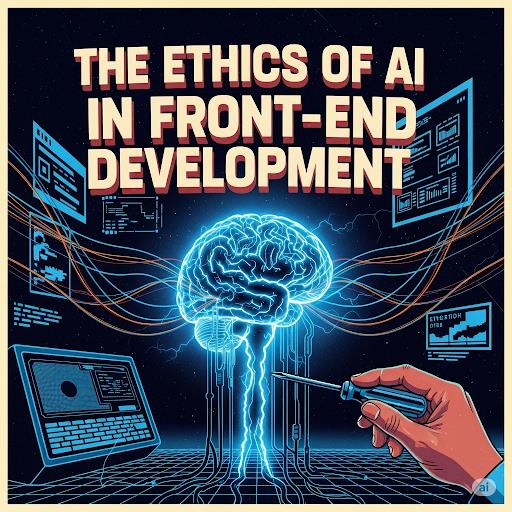Artificial Intelligence (AI) is no longer a futuristic concept—it’s a present-day force transforming how we build and experience the web. In front-end development, AI is revolutionizing everything from personalized content delivery to intelligent UI components, accessibility enhancements, and even automated code generation. These innovations promise faster development cycles, more engaging user experiences, and smarter interfaces.
But with this power comes a profound ethical responsibility.
As developers, designers, and product teams, we are not just building interfaces—we are shaping how people interact with technology, how they make decisions, and how they perceive the world.
In this article, we’ll explore the ethical considerations of using AI in front-end development, common pitfalls to avoid, and practical steps you can take to build better, more responsible interfaces.
Why Ethics Matter in Front-End AI
Front-end development is about people. It’s where your users interact with your product. When you introduce AI into the front end, you’re shaping what users see, how they interact, and even how they think about your brand or service.
That gives us significant influence—and responsibility.
AI in the front end can:
- Personalize content to match user preferences, increasing relevance and engagement.
- Assist users by predicting needs, auto-completing tasks, or offering intelligent suggestions.
- Simplify complex workflows, making digital experiences more intuitive.
But it can also:
- Create filter bubbles, limiting exposure to diverse perspectives.
- Exploit user behavior for engagement metrics, leading to addictive patterns.
- Obscure decision-making, making it hard for users to understand or challenge outcomes.
Ethics is the compass that ensures we use AI to empower users—not manipulate or marginalize them.
Common Ethical Pitfalls in AI-Powered Front Ends
1. Lack of Transparency
Many AI features operate behind the scenes, leaving users unaware that algorithms are shaping their experience. This lack of clarity can erode trust and lead to confusion or suspicion.
Examples:
- A news feed that prioritizes content without explaining why.
- A recommendation engine that never discloses its criteria.
- A chatbot that mimics human conversation without revealing it’s AI-driven.
Ethical Principle: Be transparent. Clearly communicate when and how AI is being used. Offer explanations like “Why am I seeing this?” and allow users to opt out of AI-driven personalization.
2. Bias and Discrimination
AI systems learn from data—and data often reflects societal biases. If not carefully audited, these biases can be amplified in the front end, leading to unfair or discriminatory outcomes.
Examples:
- A job board that shows high-paying roles predominantly to men.
- A beauty app that favors lighter skin tones in filters.
- A loan application interface that subtly discourages certain demographics.
Ethical Principle: Audit for bias. Regularly test AI outputs across diverse user groups. Use fairness toolkits like Fairlearn or AI Fairness 360 to detect and mitigate bias.
3. Privacy Violations
Front-end AI often relies on user data—clicks, scrolls, locations, preferences. Without strict safeguards, this can lead to overreach, surveillance, or even data breaches.
Examples:
- Tracking user behavior without consent.
- Collecting location data unnecessarily.
- Using interaction data to infer sensitive traits.
Without proper consent and data minimization, this can easily cross ethical boundaries.
Ethical Principle: Respect privacy. Collect only what you need, anonymize where possible, and always obtain informed, explicit consent. Implement clear privacy controls and explain how data is used.
4. Manipulative UI (Dark Patterns)
AI can optimize for engagement—but at what cost? When algorithms prioritize metrics like time-on-site or ad clicks, they can lead to manipulative design choices that harm users.
Examples:
- Infinite scrolls that discourage breaks.
- Notifications designed to trigger anxiety or FOMO.
- Interfaces that make opting out difficult or confusing.
Ethical Principle: Prioritize user well-being. Design for clarity, not addiction. Give users control over their experience and avoid deceptive tactics.
Practical Steps for Ethical AI in Front-End Development
1. Practice AI Transparency
- Add AI disclaimers or explanations in the UI.
- Provide “Why am I seeing this?” options for recommendations.
- Offer opt-out choices for AI-powered personalization.
2. Perform Bias Testing
- Test AI behavior across age, gender, ethnicity, and other factors.
- Involve diverse groups in usability testing.
- Use tools like Fairlearn or AI Fairness 360 to evaluate bias.
3. Build for Privacy
- Use anonymization and differential privacy where possible.
- Store data locally (client-side) when you don’t need to upload it.
- Implement clear, understandable privacy controls.
4. Avoid Dark Patterns
- Favor user agency: allow users to control AI behavior.
- Avoid tricks that artificially increase time-on-site.
- Monitor whether AI optimizations are serving users or merely driving KPIs.
5. Stay Educated and Informed
- Follow AI ethics research.
- Engage with communities discussing responsible AI.
- Participate in open discussions within your team about potential ethical risks.
The Future: Towards Responsible AI UX
The ethical use of AI in front-end development is still evolving. Here are some emerging trends that will shape the future:
- Explainable AI (XAI)
Making AI decisions understandable to users is key to building trust. Expect more tools and frameworks that help developers surface the “why” behind AI outputs.
- User-Centric AI
Designing AI that collaborates with users—rather than dictating outcomes—will become a standard. Think of AI as a co-pilot, not a controller.
- Regulatory Frameworks
Laws like the EU AI Act and other global regulations will increasingly define what’s acceptable in AI-powered interfaces. Staying compliant will require ethical foresight and technical agility.
Final Thoughts
Front-end developers are the last line of defense between powerful AI systems and the people who use them. The choices we make—what to show, how to explain it, and how much control to give—have real consequences.
By adopting an ethical mindset, practicing transparency, protecting privacy, and avoiding manipulation, we can help ensure that AI makes the web a more empowering—not exploitative—place.
By embracing ethical principles, we can:
- Build trust with users.
- Create inclusive, respectful experiences.
- Lead the way in responsible innovation.
Remember: Just because you can do something with AI doesn’t mean you should. Let ethics guide your creativity, and you’ll build not just smarter interfaces—but better ones.


